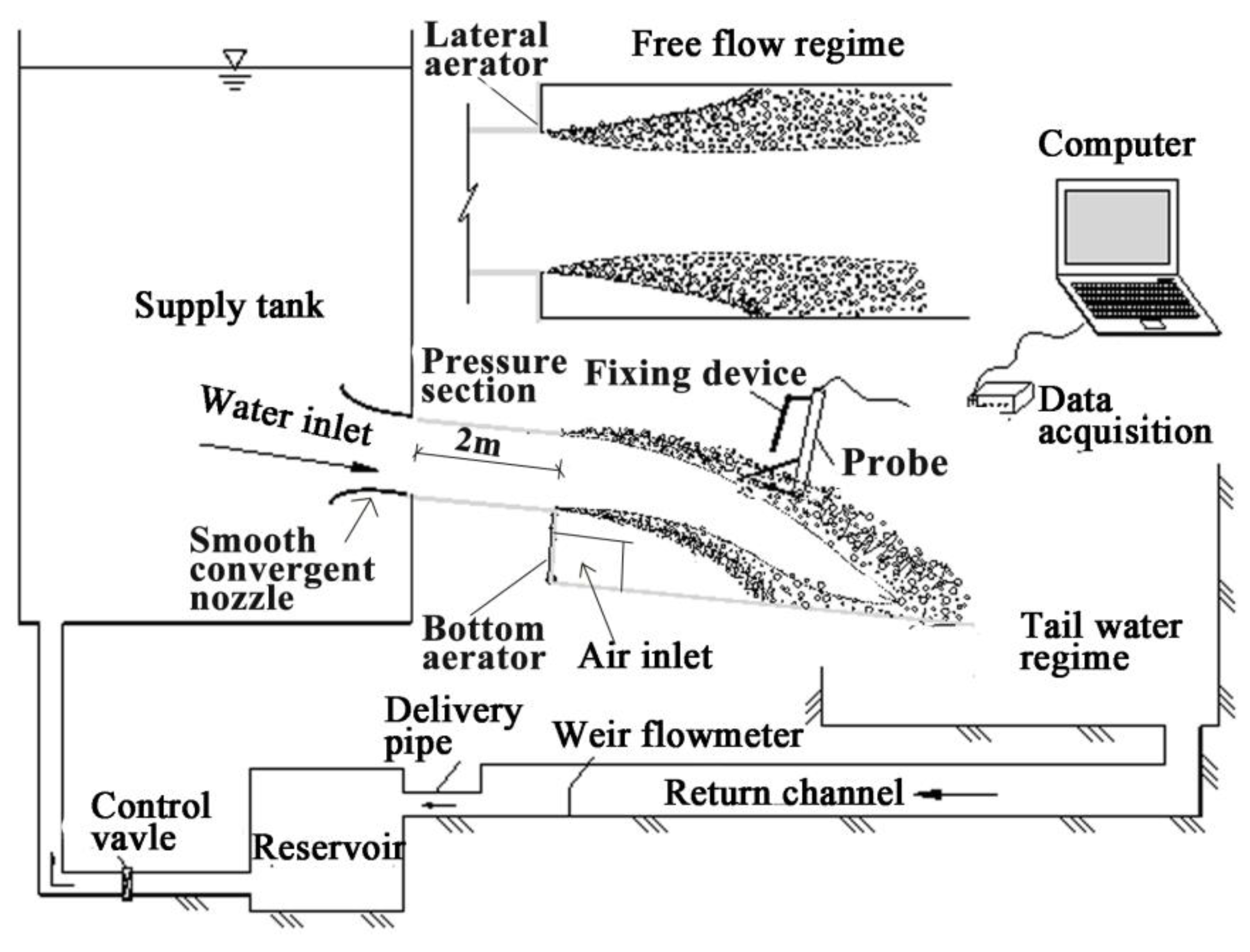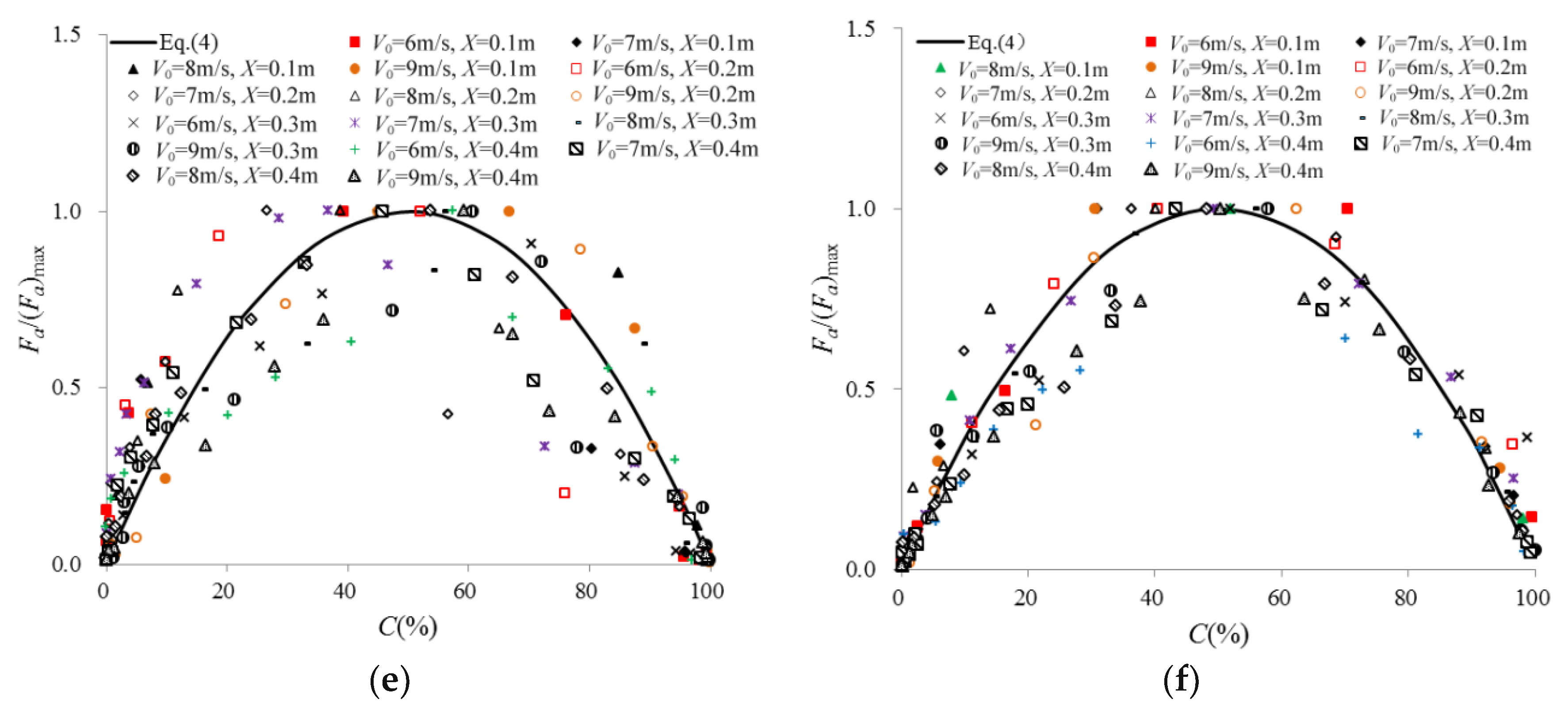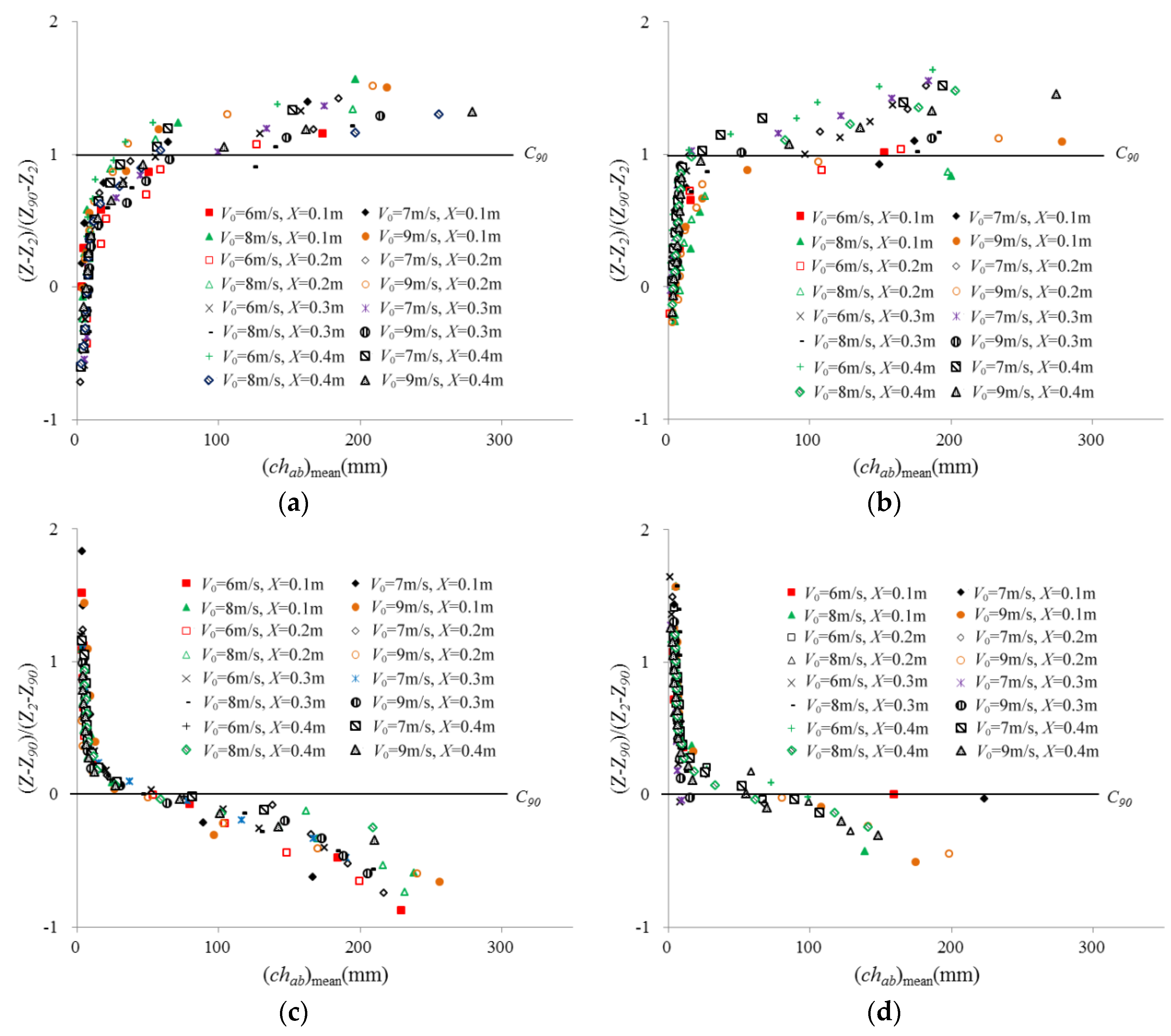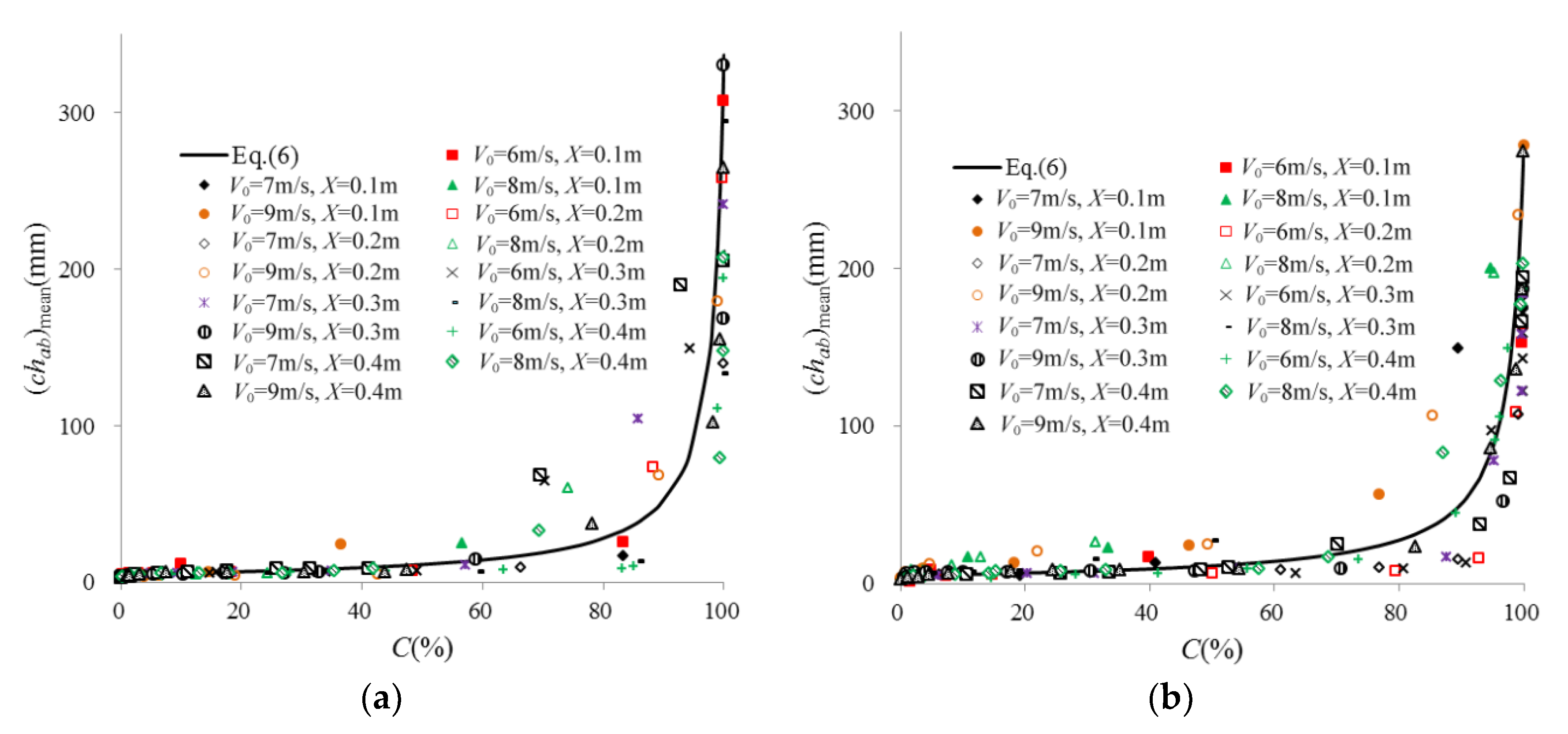Three-Dimensional Aerators: Characteristics of the Air Bubbles
Abstract
:1. Introduction
2. Experimental Setup
3. Results
3.1. Air Bubble Frequency
3.2. Air Bubble Chord Length Distributions
4. Discussion
5. Conclusions
- (1)
- The air bubble frequency distributions (yielding to the Gauss function) exhibit a unitary self-similarity along the air–water layer, presenting a trend which initially increases and then decreases from the air–water interface to the inside of the water. A quasi-parabolic relationship between the air bubble frequency and the air concentration is obtained for the upper, lower and side nappes.
- (2)
- The air bubble frequency reaches to apex at approximately C = 50%, and then decreases to zero as C = 0% and C = 100%. The relative location at which the maximum air bubble frequency is observed is at 0.21, 0.326 and 0.283 times of the thickness of the air–water layers for the upper, lower and side nappes, respectively.
- (3)
- The air bubble chord length decreases gradually from the free interface to the interior of the water. When the air bubble chord size is plotted against the air concentration, the resulting distribution follows a power-law function. The relationship between the air bubble frequency and bubble chord size exhibits a “modified” gamma function for the upper, lower and side nappes.
Author Contributions
Funding
Conflicts of Interest
Notations
| empirical coefficients | |
| b | the width of sudden fall-expansion aerator |
| B | width of the pressure outlet |
| air concentration | |
| the air bubble chord length size | |
| the average value of air bubble chord length | |
| air bubble chord length | |
| i | air bubble number |
| air bubble frequency | |
| the maximum bubble frequency | |
| Fr | Froude Number |
| g | gravitational acceleration |
| h | the height of sudden fall-expansion aerator |
| H | height of the pressure outlet |
| the unit-width discharge | |
| Reynolds number | |
| the number of detected bubbles | |
| the count of air bubbles | |
| the number of air-structures | |
| Ri | a ratio of the bubble measured in the whole measurement time |
| t | time |
| the cross-sectional mean velocity at the pressure outlet | |
| X, Y, Z | the horizontal, transverse and vertical coordinates of the lower nappe profile |
| the slope with respect to the horizontal downstream bottom plane | |
| Y2, Z2 | characteristic air–water flow heights where the air concentration C = 2%; |
| Y90, Z90 | characteristic air–water flow heights where the air concentration C = 90% |
| characteristic depth corresponding to the air bubble frequency | |
| degree of deviation between the relative depth and its mean value | |
| the probability density function of the gamma function | |
| the shape parameter | |
| the scale parameter | |
| the gamma function |
References
- Cassidy, J.; Elder, R. Spillways of High Dams, Developments in Hydraulic Engineering—2; Elsevier: New York, NY, USA, 1984. [Google Scholar]
- Kells, J.A.; Smith, C.D. Reduction of cavitation on spillways by induced air entrainment. Can. J. Civ. Eng. 1991, 18, 358–377. [Google Scholar] [CrossRef]
- Hager, W.H.; Pfister, M. Historical advance of chute aerators. In Proceedings of the 33rd IAHR Congress, Vancouver, BC, Canada, 9–14 August 2009; pp. 5827–5834. [Google Scholar]
- Pfister, M.; Lucas, J.; Hager, W.H. Chute aerators: Pre aerated approach flow. J. Hydraul. Eng. 2011, 137, 1452–1461. [Google Scholar] [CrossRef]
- Hager, W.H.; Boes, R.M. Hydraulic structures: A positive outlook into the future. J. Hydraul. Res. 2014, 52, 299–310. [Google Scholar] [CrossRef]
- Low, H.S. Model Studies of Clyde Dam Spillway Aerators; Research Report, No. 86-6; Department of Civil Engineering, University of Canterbury: Christchurch, New Zealand, 1986. [Google Scholar]
- Zhang, J.M.; Wang, Y.R.; Yang, Q.; Xu, W.L. Scale effects of incipient cavitation for high-speed flows. Proc. Inst. Civ. Eng. Water Manag. 2013, 166, 141–145. [Google Scholar] [CrossRef]
- Chanson, H. A study of Air Entrainment and Aeration Devices on a Spillway Model. Ph.D. Thesis, Department of Civil Engineering, University of Canterbury, Christchurch, New Zealand, 1988. [Google Scholar]
- Chanson, H. Air Bubble Entrainment in Free-Surface Turbulent Flows: Experimental Investigations; Research Report No. CH46/95; Department of Civil Engineering, University of Queensland: Brisbane, Australia, 1995. [Google Scholar]
- Chanson, H.; Brattberg, T. Experimental Investigations of Air Bubble Entrainment in Developing Shear Layer; Research Report, No. CH48/97; Department of Civil Engineering, The University of Queensland: Brisbane, Australia, 1997. [Google Scholar]
- Brattberg, T.; Chanson, H.; Toombes, L. Experimental investigations of free-surface aeration in the developing flow of two-dimensional water jets. J. Fluids Eng. 1998, 120, 738–744. [Google Scholar] [CrossRef]
- Chanson, H. Air bubble entrainment in open channels: Flow structure and bubble size distributions. Int. J. Multiphase Flow 1997, 23, 193–203. [Google Scholar] [CrossRef] [Green Version]
- Toombes, L. Experimental Study of Air-Water Flow Properties on Low-Gradient Stepped Cascades. Ph.D. Thesis, Department of Civil Engineering, University of Queensland, Brisbane, Australia, 2002. [Google Scholar]
- Li, S.; Zhang, J.M.; Chen, X.Q.; Zhou Gordon, G.D. Air concentration and velocity downstream of an expanding chute aerator. J. Hydraul. Res. 2018, 56, 412–423. [Google Scholar] [CrossRef]
- Li, S.; Zhang, J.M.; Chen, X.Q.; Chen, J.G.; Zhou Gordon, G.D. Cavity length downstream of a sudden fall-expansion aerator in chute. Water Sci. Technol. Water Supply 2018, 18, 2053–2062. [Google Scholar] [CrossRef]
- Pfister, M.; Hager, W.H. Deflector-generated jets. J. Hydraul. Res. 2009, 47, 466–475. [Google Scholar] [CrossRef]
- Kramer, K.; Hager, W.H. Air transport in chute flows. Int. J. Multiphase Flow 2005, 31, 1181–1197. [Google Scholar] [CrossRef]
- Pfister, M.; Hager, W.H. Chute aerators. I: Air transport characteristics. J. Hydraul. Eng. 2010, 136, 352–359. [Google Scholar] [CrossRef]
- Toombes, L.; Chanson, H. Interfacial aeration and bubble count rate distributions in a supercritical flow past a backward-facing step. Int. J. Multiphase Flow 2008, 34, 427–436. [Google Scholar] [CrossRef] [Green Version]
- Zhang, J.M.; Chen, J.G.; Xu, W.L.; Wang, Y.R.; Li, G.J. Three-dimensional numerical simulation of aerated flows downstream sudden fall aerator expansion-in a tunnel. J. Hydrodyn. Ser. B 2011, 23, 71–80. [Google Scholar] [CrossRef]
- Toombes, L.; Chanson, H. Free-surface aeration and momentum exchange at a bottom outlet. J. Hydraul. Res. 2007, 45, 100–110. [Google Scholar] [CrossRef] [Green Version]
- Fuhrhop, H.; Schulz, H.E.; Wittenberg, H. Solution for spillway chute aeration through bottom aerators. Int. J. CMEM 2014, 2, 298–312. [Google Scholar] [CrossRef] [Green Version]
- Bai, Z.L.; Peng, Y.; Zhang, J.M. Three-Dimensional Turbulence Simulation of Flow in a V-Shaped Stepped Spillway. J. Hydraul. Eng. 2017, 143, 06017011. [Google Scholar] [CrossRef]
- Duarte, R. Influence of Air Entrainment on Rock Scour Development and Block Stability in Plunge Pools. Ph.D. Thesis, EPFL-LCH, Lausanne, Switzerland, 2014. [Google Scholar]
- Peng, Y.; Mao, Y.F.; Wang, B.; Xie, B. Study on C-S and P-R EOS in pseudo-potential lattice Boltzmann model for two-phase flows. Int. J. Mod. Phys. C 2017, 28. [Google Scholar] [CrossRef]
- Peng, Y.; Wang, B.; Mao, Y.F. Study on force schemes in pseudopotential lattice Boltzmann model for two-phase flows. Math. Probl. Eng. 2018, 2018, 6496379. [Google Scholar] [CrossRef]
- Peng, Y.; Zhang, J.M.; Meng, J.P. Second order force scheme for lattice Boltzmann model of shallow water flows. J. Hydraul. Res. 2017, 55, 592–597. [Google Scholar] [CrossRef]
- Chanson, H. Hydraulics of aerated flows: Qui pro quo? J. Hydraul. Res. 2013, 51, 223–243. [Google Scholar] [CrossRef]
- Chen, X.P.; Shao, D.C. Measuring bubbles sizes in self-aerated flow. Water Res. Hydropower Eng. 2006, 37, 33–36. [Google Scholar]
- Bai, R.; Liu, S.; Tian, Z.; Wang, W.; Zhang, F. Experimental Investigation of Air–Water Flow Properties of Offset Aerators. J. Hydraul. Eng. 2017, 144, 04017059. [Google Scholar] [CrossRef]
- Gonzalez, C.A. An Experimental Study of Free-Surface Aeration on Embankment Stepped Chutes. Ph.D. Thesis, Department of Civil Engineering, The University of Queensland, Brisbane, Australia, 2005. [Google Scholar]
- Chanson, H. Turbulent air-water flows in hydraulic structures: Dynamic similarity and scale effects. Environ. Fluid Mech. 2009, 9, 125–142. [Google Scholar] [CrossRef] [Green Version]
- Heller, V. Scale effects in physical hydraulic engineering models. J. Hydraul. Res. 2011, 49, 293–306. [Google Scholar] [CrossRef]



















| Series | (h, b)/m | θ |
|---|---|---|
| 1 | (0.025, 0.000) | 10% |
| 2 | (0.045, 0.000) | 10% |
| 3 | (0.065, 0.000) | 10% |
| 4 | (0.000, 0.025) | 10% |
| 5 | (0.000, 0.045) | 10% |
| 6 | (0.000, 0.065) | 10% |
| 7 | (0.025, 0.025) | 10% |
| 8 | (0.045, 0.045) | 10% |
| 9 | (0.065, 0.065) | 10% |
| 10 | (0.045, 0.045) | 0% |
| 11 | (0.000, 0.045) | 0% |
| 12 | (0.045, 0.000) | 0% |
| 13 | (0.045, 0.045) | 25% |
| 14 | (0.000, 0.045) | 25% |
| 15 | (0.045, 0.000) | 25% |
| Nappe | μ0 | σ0 |
|---|---|---|
| lower | 0.326 | 0.419 |
| upper | 0.210 | 0.413 |
| side | 0.283 | 0.423 |
© 2018 by the author. Licensee MDPI, Basel, Switzerland. This article is an open access article distributed under the terms and conditions of the Creative Commons Attribution (CC BY) license (http://creativecommons.org/licenses/by/4.0/).
Share and Cite
Li, S.; Zhang, J.; Chen, X.; Chen, J. Three-Dimensional Aerators: Characteristics of the Air Bubbles. Water 2018, 10, 1430. https://doi.org/10.3390/w10101430
Li S, Zhang J, Chen X, Chen J. Three-Dimensional Aerators: Characteristics of the Air Bubbles. Water. 2018; 10(10):1430. https://doi.org/10.3390/w10101430
Chicago/Turabian StyleLi, Shuai, Jianmin Zhang, Xiaoqing Chen, and Jiangang Chen. 2018. "Three-Dimensional Aerators: Characteristics of the Air Bubbles" Water 10, no. 10: 1430. https://doi.org/10.3390/w10101430




